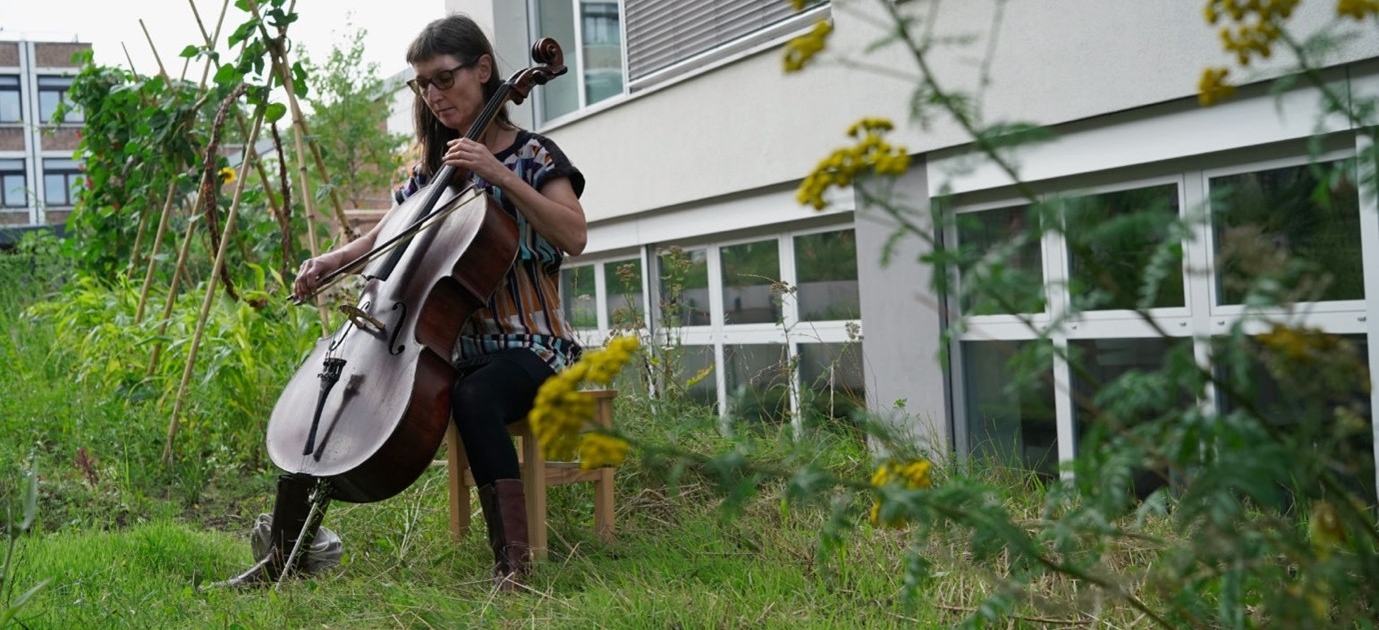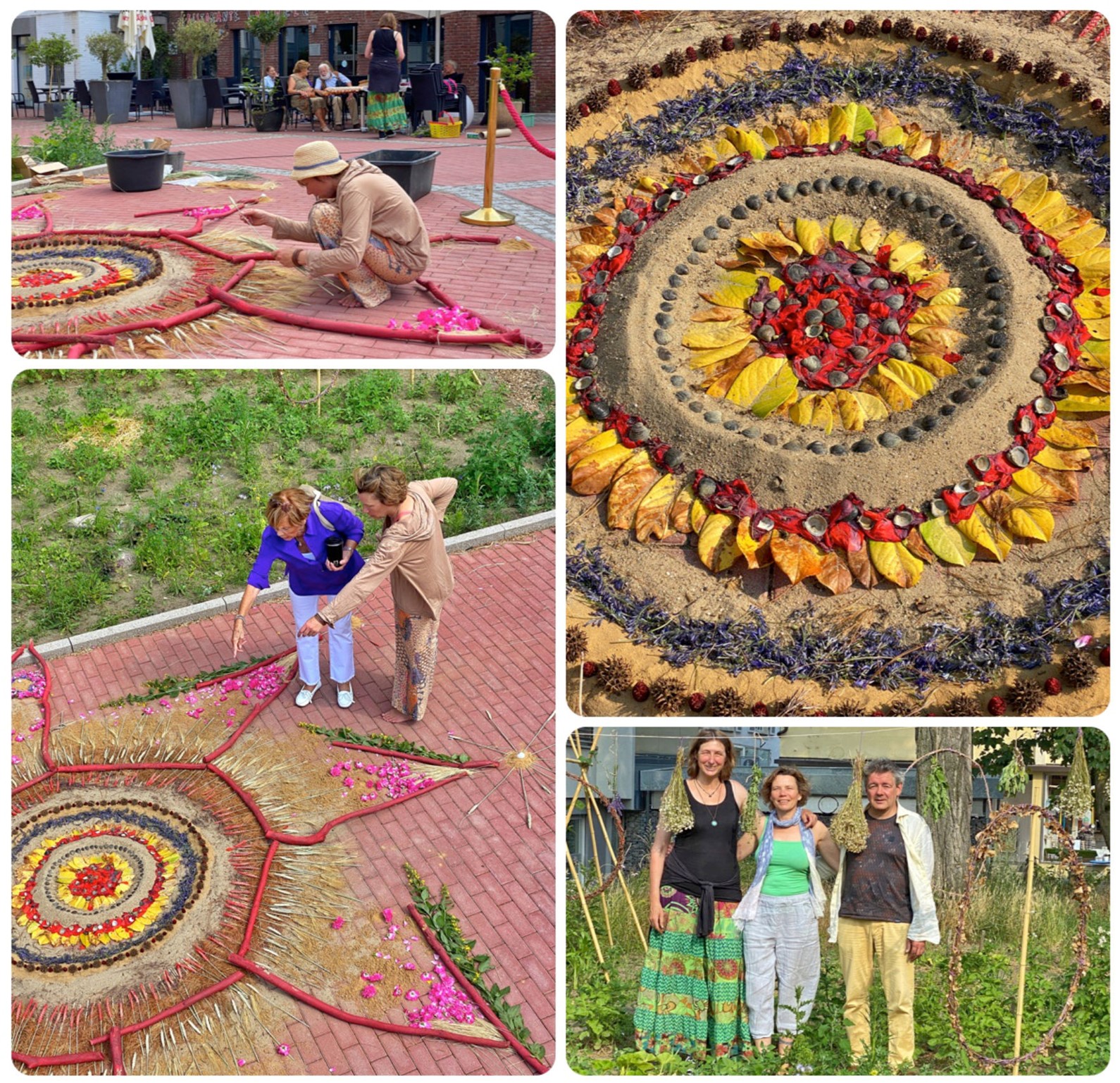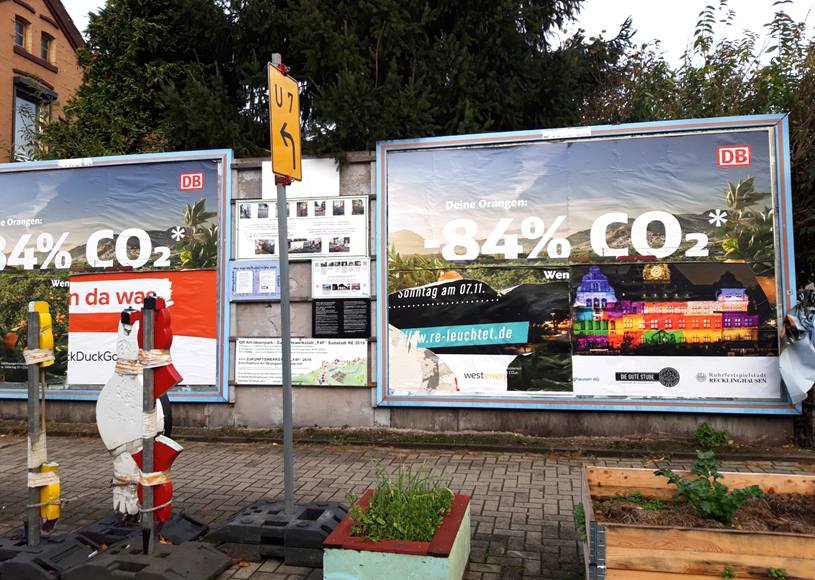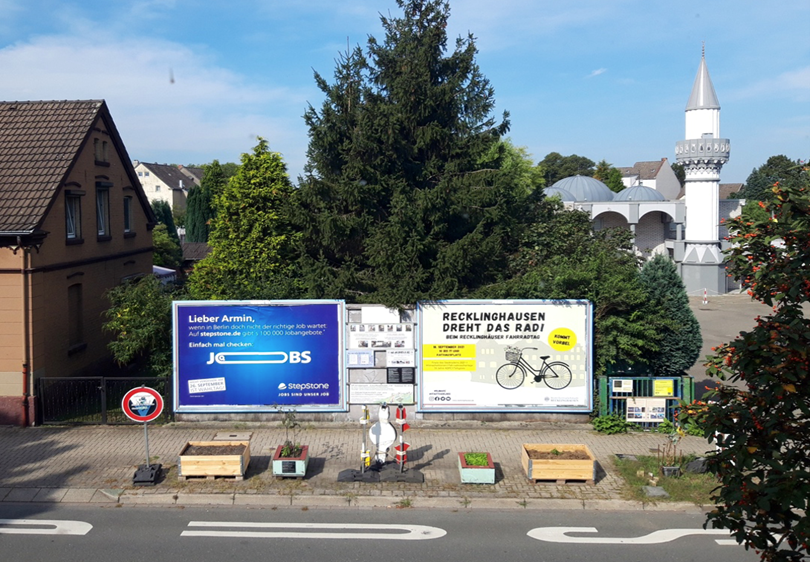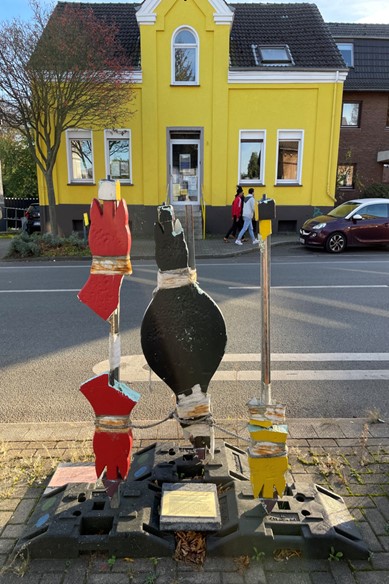Concert contribution as part of Martin Kessler’s “Perception” campaign in the urban garden Kopf-Stadt-Salat, Recklinghausen. Photo: Markus Jöhring.
This month’s blog is in two parts, read the first part here
Axel Schuch (underground metal worker, graphic designer, environmental artist), Cordula Grüner (linguist, art activist) and Ute Eickelkamp (social anthropologist), all affiliated to Campus Emschlerand
As deindustrialisation changes life-worlds and landscapes, it transforms public places and spaces, and even creates new ones. We, a collaborative research team, hone in on the perspectives and practices of living in public that people who see themselves as “working class folk” have forged in Germany’s former heartland of heavy industries, the Ruhr Valley. In Part 1, historian Stefan Berger and social anthropologist Ute Eickelkamp pursued how people have used “green” spaces created as such for them, and places that have been made and sustained by or with them, such as their allotment gardens or fishing spots by the canal. In this second part, art activists Axel Schuch and Cordula Grüner, with Ute, observe how frictions arise as artists push their work in the name of a participatory social-ecological transformation out of the galleries and into the streets, that is, into interstitial, sometimes hidden places and legal grey zones. Our focus is on the perceptions of and interactions with environmental artworks that appropriate public space in the Ruhr’s northern city of Recklinghausen, and which are inspired by Joseph Beuys’ “social sculpture”. We ask: What are the societal triggers that push collaborative art with people, plants and soil out of place? And what does it mean for the deindustrialization of mindscapes when green art provokes a contest for public space?
Setting the scene
Recklinghausen is a district town with around 115,000 inhabitants. It lies within the core area of the natural region “Emscherland”, whose eponymous river embodies the history of industrialization and deindustrialization of the Ruhr region. This is a divided city, marked by a historical rift between the culturally rich, leafy old town and the proletarian-industrial southern districts. Three hard coal mines operating between 1869 and 2001 were all located outside the old town, which had been the only built-up area until industrialization. The southern suburbs of Recklinghausen border onto the Emscher river – victim of the industrial urbanization of the region as open wastewater canal carrying hazardous toxic effluent of the rich and poor alike into the Rhine. Between 1992 and 2022, the Emscher river system was restored to a near-natural state, enabled by a new state-of-the-arts subterranean wastewater canal. Together with the water manager, the Emscher Cooperative, and a business and activist network, the city is committed to the UN sustainability goals and is implementing a climate mitigation plan. We present two “failed” art interventions that sought to foster ecological practice as a form of social caring, one in the inner city, the other in a former mining suburb. Axel Schuch discusses his own collaborative work of an inner city garden, while Cordula Grüner and Ute Eickelkamp write about a climate station in the south, in which all three authors were involved, but which was conceived and realized by the late Reiner Kaufmann.
“Kopf-Stadt-Salat” (Head-City-Lettuce): Urban Gardening
In 2018, the year coal production in the Ruhr ended, the city of Recklinghausen adopted its cultural development plan, which sets out the guidelines for the next ten years in the areas of art, culture, and education.
In November 2022, the cultural administration of the city of Recklinghausen approached me, Axel Schuch, with a corresponding request for the plan’s objective “Urban Gardening / Art Communication by Other Means”. Especially because of one passage in the project contract, “relevant for the future in the sense of an expanded concept of culture” , I was enthusiastic about this option to create a communicative and possibly sustainable art garden—living art!
Three artists of our already established urban art StadtLabor (CityLab) set to work on a 200 square meter-large field of heavily compacted earth, adjacent to the city library, a high-end Italian restaurant and the city’s oldest church and almshouse.
To meet the requirements of the relevant section of the cultural development plan, we approached the site as a social sculpture pivoting on common land, soil de-sealing, an inner-city place of rest, and creative communication. This aligned with the city council’s understanding of urban gardening as revitalization and sustainable transformation of urban wastelands, a space free from commercial pressures and dedicated to experimenting with creative and ecological ideas. The council plan emphasized freedom in the face of “an increasingly structured, controlled and monitored urban environment.” As it turns out, this freedom was of a rather limited kind.
“Dance of Desires”
“Dance of Desires” (Tanz der Begehrlichkeiten) was one in a series of street art projects in the city’s south that challenge ownership of public space. Reiner Kaufmann (1940 – 2025) began installing an art-transformation-place in the former mining suburb of König-Ludwig in 2015, implementing street art as a psycho-socio-ecological laboratory – with the people, for the people, and heeding the rights of plants. Each project evolved organically out of earlier ones, and is marked by signature silhouette sculptures of horses. The equine statues originate in school children’s drawings and are “messengers”: they recall the wild and feral horses that lived along the Emscher before the river was canalized and industrialization took away their marshland home, while simultaneously looking into the future.
Kaufmann’s living and artwork studio The Yellow House on König-Ludwig-Street leads to the coal mine of the same name which, during the winter of 1946/47, cooperated with Hamburg theatres, bartering (illegally) art for coal at a time when the mine was under British military control. This precarious moment formed the beginning of the Ruhrfestspiele (Ruhr Theatre Festival), now a major international art event in the city centre, which has taken place every year since. The König-Ludwig-Mine closed in 1965, leaving this working-class settlement to struggle with the legacies of deindustrialization. Industrial heritage sites, new commercial enterprises (including a bio cogeneration plant), high unemployment and high numbers of old and new migrants live here side by side.
“Dance of Desires” animates a retired bus stop beneath large commercial billboards opposite The Yellow House and directly next to a Turkish mosque. It is a passageway as school students and local residents walk past daily. Before Kaufmann began installing raised garden beds, sculptures, signs, posters and stepping stones, locals were using the widened footpath of the old bus stop as a car park. But it was never zoned as such, nor as a pedestrian walkway. Reasoning that accessibility creates a link between the numerous ethnic communities in the area, Kaufmann saw here a perfect space to stimulate debate about environmental issues and intercultural communication. Approved as a temporary art installation, such spatial appropriation, however, caused friction between participating artists, interested audiences, orderly neighbours and the urban administration. The horses were damaged, more and more pieces broken off, so Kaufmann began to bandage their wounds. A climate station with herbal plants that were deliberately left to their own devices, registered the environment and showed up the strains on life by the roadside – human and otherwise. This was anything but the pots of “pretty flowers” traditionally deployed to beautify proletarian and inner city neighborhoods. Following anonymous complaints about the site’s “disorderly” appearance and a penalty ticket for misuse of public space, the city council dismantled the installation.
By way of response, and through yet another collaboration with the mosque community, a small patch of earth on the footpath where a council tree had died, was socially reanimated. We “planted” the root of a pear tree head down-roots up as a sign of resilience in adverse conditions, anchored in the ground by a strong iron chain and thus secured against – what, really? Official removal, clandestine theft, or co-creative vandalism? Then, artists and neighbours achieved the preservation of the body of yet another dead tree that could not take root. Stripped of its crown, the trunk was left standing like a memorial that, in time, ivy might overgrow. We note here that, in Germany, every single tree, dead or alive, exists in the land registry office. This tree marked with an X for felling, is registered and therefore legal and permanent – an act of persistent ambiguity.
Verboten, verboten
Contrary to the established preconditions and the freedom of art guaranteed by the German Constitution in § 5.3, our inner city gardening project was confronted with several restrictions:
The initial planting of an elder tree, which was to be consecrated according to Nordic ritual, was prohibited. The council argued that the area was an ideology-free (!) space. In a protest note to the city, we pointed out that, according to this rule, Christmas lights should not be put up in public either.
No seating was allowed to be installed to prevent homeless people and bums to rest. So we built a raised bed with an edge – a hidden seat.
To protect the site from being misused as a dog toilet, we wanted to set up a low, natural picket fence. However, for insurance reasons, it was suddenly no longer possible to “put up a fence in an inner-city area.” Instead, we planted a hawthorn hedge, which, although it has very sharp and long thorns, was not deemed unlawful.
A mentally ill homeless person regularly defecated on the site. We found a solution here too: a composter was set up right in the man’s toilet spot. From then on, the homeless person didn’t want to contribute anything more. City and police measures had been ineffective up to that point.
Art in disguise
The installation of sculptures in public spaces is prohibited. Any such proposal would first have to be reviewed by a municipal cultural commission and then discussed and approved by the city council. This contradicted the council’s expanded cultural concept and meant that the inner-city garden could not contain any works of art classified as such. In response, we launched a “scarecrow campaign.” The artists were completely free to decide what the scarecrows should look like. This approach kept the law enforcement authorities at bay: scarecrows are classified as gardening aids and not as works of art.
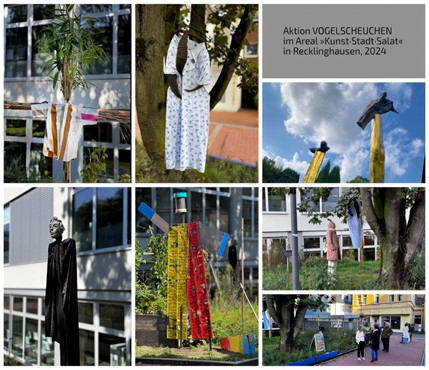
“Vogelscheuchen” (Scarecrows) campaign in the Kunst·Stadt·Salat urban garden in Recklinghausen City, 2024. Photos: Axel Schuch.
When the council removed Kaufmann’s art at the former bus stop, we pondered what was really being discarded – street art, a potential for place-making in the spirit of commoning, or a conflict over the right kind of urban nature? Regardless, the sculptures and other items might not roam the sidewalk anymore, but the art persists otherwise, in disguise: Kaufmann parked his art motorcar on the illegal but seemingly acceptable “carpark” with the art materials packed inside, occasionally swapping the car with a postman’s bicycle turned mobile sculpture.
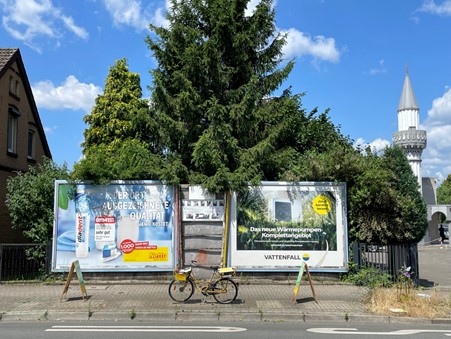
Art-transformation-place with decommissioned bicycle parked on the decommissioned bus stop. Photo: Cordula Grüner, 2024.
Conclusion
On the one hand, we created unusual cultural spaces that were successful in the intended sense of being socially productive and ecologically mindful. There were numerous fruitful conversations and discussions in the context of the art events. People were enthusiastic. On the other hand, there were collisions. The image of “untidy” nature in the midst of the “clean” appearance of urban architecture in the inner city as well as in the streets of the mining suburb, was not tolerated. In the case of the inner city garden, the ecological, sustainable and content-oriented focus of the project aroused hostility especially from local businesses; it clashed with their interest in a commercial space.
While they existed, the public spaces seized by art registered the human and more-than-human environment; they are part of the socio-urban-ecological “system,” and they must endure this. But for the city administration and some neighbours alike, such artful dwelling that also mirrored the darker sides of life, was perceived as out of place – a transgression of categories deemed dangerously disorderly, unsightly, even immoral, and was thus “prohibited.” The contrast between these “lively oases” as expanded culture concept, and the hygiene of the anything-but-ideology-free space after the evictions could not be starker.

